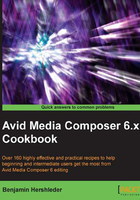
Understanding Media Creation settings
It's important to spend some time setting up your Media Creation settings. Essentially Media Creation settings allow you to set defaults, which will help ensure that the media files you create (for example, render files, imports, and so on) are stored where you want them and are of the resolution you need. Plus, it will save you time making selections in various dialog boxes and tools throughout the workday.
Getting ready
In your Project Window select the Format tab. Select the format of the media that you will be capturing, importing, and/or rendering. Media Composer will remember your Media Creation settings for each format that you configure. So, for example, if you're mixing SD and HD footage, you'll configure your Media Creation settings for each. Once your preferences are set in the Media Creation tool for each format, Media Composer will automatically switch to your customized settings whenever the format itself is switched.
How to do it...
The following steps will guide you through using the Media Creation Tool:
- Go to the Tools menu at the top of your screen.
- Select Media Creation.
- Proceed section by section to set defaults for the resolution of the media that you create, as well as for the destination for that media. See the following How it works... section for details.
How it works...
The settings are separated by tabs, described as follows:
- Filter Network Drives Based on Resolution: Selecting this will not allow media files to be placed on any network drives that Media Composer feels will not be able to reliably capture or playback files of a particular resolution. For example, you open your Capture Tool and set the resolution to 1:1. Then when you go to select a drive to store your media files on, you may see that one is grayed out and not selectable. If you then change your resolution to 3:1, you may find that it is now selectable as a storage drive.
- Filter Out System Drive: Selecting this will not allow the media files to be stored on the same drive that your operating system is installed on.
- Filter Out Launch Drive: Selecting this will not allow the media files to be stored on the same drive that your Media Composer software is installed on.
Under each tab you can select a default resolution. You are not locked into this resolution. Tools and dialog windows will still allow you to override this default whenever you want.
Apply to All: If you'd like to set a specific resolution and have it applied to all the different media type tabs, rather than having to do it one by one, simply click on the Apply to All button.
The benefit of breaking the media types into categories, such as Capture, Render, and Import, is that you can then set different defaults for each. For example, on a project with many hours of taped footage, you might elect to capture all of your footage at a low resolution in order to increase how much media will fit onto your drive(s). This will mean that when the project is creatively finished, you will go through a second process to recapture just the video portions that are being used at a much higher resolution, a process frequently called the Up-Res, so that the image quality will be higher. You may prefer to not have to go through a similar process for all of the titles, still images, and motion graphics, so you could elect to set the default for these media types at the level where you need them to be for the final master (for example, 1:1).
Under each tab, you can select a default location for the media types to be stored. You are not locked into this. Various tools and dialog windows will still allow you to override this default when desired.
This selection is helpful for ensuring files go where required, and it allows you to send render files (known in Avid terminology as Precompute files) to a specific drive if required by your facility.
Apply to All: If you want the storage drive to be the same for all the different media type tabs, rather than having to do it one by one, simply click on the Apply to All button.
Changing this is only possible for SD video, as HD will always be in the MXF format. Media Creation settings will default to the file format called Material Exchange Format (MXF). You should not change this unless you are in the unique situation where you are generating media on one workstation that will have to be used on a much older workstation that can only play the Open Media Framework (OMF) file format.